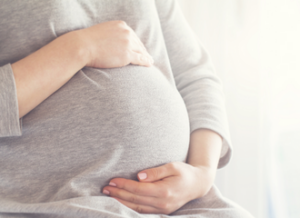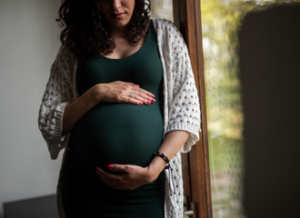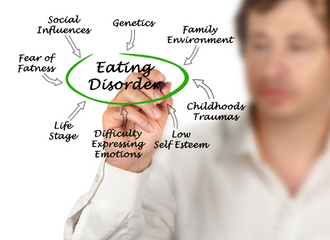Written by: Angela Kaloudis, LMHC, PMH-C, NCC (she/her/hers)
Clinical Training Specialist
Being pregnant is a particularly vulnerable period for individuals with active and inactive eating disorders. In fact, it’s been stated that pregnancy and postpartum are the eating disorder triggers that no one talks about.

Some have reported that they thought being pregnant would bring them the motivation they needed to recover1. Some make it through pregnancy without experiencing eating disorder symptoms, only to relapse after giving birth – a time when they have little control over their new lives as a parent and/or may be living in a body they may not recognize.
In all of the above scenarios, pregnancy can bring internal conflict and evoke feelings of shame, embarrassment, and extreme discomfort. There are specific triggers during pregnancy such as weight gain, food aversions, food preferences and cravings, disrupted sleep, morning sickness, and/or nausea and vomiting throughout the pregnancy (hyperemesis gravidarum) that can worsen an active eating disorder or re-activate a previously existing one.
Eating Disorders and Perinatal Mood & Anxiety Disorders (PMADs)
Of people who are diagnosed, I in 5 pregnant and birthing individuals will meet criteria for a perinatal mood and anxiety disorder (PMAD) which includes depression, anxiety, PTSD, bipolar, and obsessive-compulsive disorder from conception to one year postpartum. Around 30 million people in the U.S. meet the criteria for an eating disorder (ED) during their lifetime. These numbers are staggering and yet, these two populations share overlapping risk factors and face similar barriers to diagnosis and treatment, so it is suspected that the numbers are even higher. A strong level of evidence supports the association between disordered eating and depressive and anxiety symptoms during pregnancy and postpartum, making individuals with eating disorders who become pregnant high risk for a perinatal mood and anxiety disorder.2
The presence of eating disorders during pregnancy and postpartum is not discussed, screened, or treated often enough in either the eating disorder world or the perinatal world, despite the noted high risk. This is especially true for the most oppressed among us such as members of the LGBTQIA+ community; BIPOC; disabled individuals; and individuals in higher weights. Unfortunately, these populations are under-represented in research, while Black women face 2x the rate for a PMAD compared to white women.
Risk Factors & Barriers to Care
The time from pregnancy to postpartum (also known as the perinatal period) is a time of challenging experiences and transitions, including hormonal shifts and physical changes that unfold in a relatively short span of time. These stressors can leave people feeling physically and mentally out of control.
Risk factors for eating disorders and PMADs include:
- Food insecurity
- A history of trauma
- Eating disorders
- Substance use disorders
- Anxiety disorders
- Mood disorders
- Obsessive-compulsive disorder
- Lack of proper screening and treatment
Barriers to diagnosis, treatment, recovery all include:
- Lack of adequate support
- A weight centric approach to care/weight stigma
- Lack of training and screening on part of the health professional (i.e., therapists, doctors, midwives, pediatricians)
- Fear of judgment
- Lack of awareness of the risks of eating disorders in pregnancy
- Fear of consequences (i.e., being labeled as an “unfit parent”) if they disclose their symptoms
Attending doctor’s appointments can evoke tremendous anxiety about being weighed, increase body image distress, discrimination, and heighten general anxiety regarding the growth of their body and their fetus. So, in addition to the above, pregnant individuals with eating concerns may not disclose their ED and/or PMAD symptoms to doctors, delaying diagnosis and increasing risk for the individual and the baby.
Medical & Physical Complications

The following complications (for birthing person and baby) are associated with eating disorders during pregnancy *regardless of body size upon conception*. 4,5
- Intrauterine Growth Restriction (IUGR), or small for gestational age
- Pre-term labor/premature birth
- Depression, anxiety
- High birth weight/low birth weight, depending on ED symptoms most prominent (e.g., restriction, compulsive and compensatory exercise, or binge eating with or without purging).
- Stillbirth
- Increased risk of cesarean birth
- Complications during labor
- Preeclampsia
- Gestational diabetes
- Gestational hypertension
Conclusion
Early, frequent, and proper screening can support outcomes for birthing individuals, their babies, and their families. An eating disorder and PMADs can improve with a multi-disciplinary team which is recommended to consist of a registered dietitian, therapist, perinatal prescriber, OB/GYN or midwife and, if accessible, a doula to help with labor, delivery and postpartum. While an eating disorder during the perinatal period can be especially difficult to overcome if you’ve been dismissed, overlooked and/or don’t have the right supports in place, eating disorder and perinatal support is out there and many pregnant and birthing people can go on to have uncomplicated labors and deliveries of healthy babies.
References:
- Sommerfeldt B, Skårderud F, Kvalem IL, Gulliksen KS and Holte A (2022). Bodies out of control: Relapse and worsening of eating disorders in pregnancy. Front. Psychol. 13:986217. doi: 10.3389/fpsyg.2022.986217
- Mischoulon, D. et al. (2011). Depression and eating disorders: treatment and course. Journal of Affective Disorders, 130.
- Delisle, R. (2021). https://www.todaysparent.com/pregnancy/pregnancy-health/pregnancy-is-the-eating-disorder-trigger-no-one-ever-talks-about/
- Ante Z, Luu TM, Healy-Profitós J, He S, Taddeo D, Lo E, Auger N. Pregnancy outcomes in women with anorexia nervosa. Int J Eat Disord. 2020 May;53(5):403-412.
- Charbonneau KD, Seabrook JA. Adverse Birth Outcomes Associated with Types of Eating Disorders: A Review. Can J Diet Pract Res. 2019 Sep 1;80(3):131-136.



